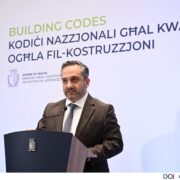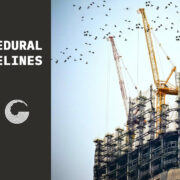CIR 05/19 | Legal Notice 136 of 2019
Legal Notice 136 of 2019 regarding Avoidance of Damage to Third Party Property Regulations, 2019, came into force on the 25th June 2019.
The publication of the Legal Notice follows a very short process of public consultation, during which the Kamra tal-Periti was not directly consulted as obliged by law. It also follows an Extraordinary General Meeting wherein the profession agreed that the following three points outlined in the draft were considered to be non-negotiable:
- That the only two figures who are responsible for construction works in terms of the Civil Code are the Perit and the Contractor. Therefore, the role of site manager as described in the draft amendments must be assumed within the Contractor’s setup, since the Contractor is obliged to understand and follow the instructions issued by the Perit, and be sufficiently knowledgeable to understand the significance of such instructions. The Contractor may employ or engage a Perit, or a suitably qualified person registered with the Building Regulation Office, without diminishing the responsibility of the Contractor in terms of the Civil Code.
- That a Geotechnical Design Report prepared in accordance with MSA EN 1997‐1 should be required for all works covered by the Legal Notice, except that the Perit in charge of the project may request an exemption from the Director BRO in circumstances where said Perit deems that such Report is not required, or only parts thereof are needed, and such request is to include detailed reasons for such request for exemption.
- That all civil works Contractors are to be registered with the Building Regulation Office by the date of coming into force of the amended Legal Notice and not permitted to work unless they are so registered and a list thereof published, and that a system of licencing based on technical ability, capacity and resources is in place by the end of March 2020.
The following is a summary of the Council’s reactions in light of the above.
- The Site Technical Officer (STO)
The Legal Notice reflects the concept that the STO is assumed within the Contractor’s setup. However a number of concerns arise out of the responsibilities assigned to the STO and the perit in charge of the project as outlined below:
- The definition of the STO states that such person is to be “nominated by the contractor and shall be approved by the perit in charge of the project.”
It is our view that the perit responsible for the development should not have the right to object to the contractor’s choice as long as the chosen STO is a warranted perit. Indeed, since the STO is, in a way, meant to supervise the application of the method statement, it would defeat the purpose of the law to have the perit of the project choose the STO.
On the other hand, the responsibility of “approving” the STO might give rise to the so-called culpa in eligendo whereby the perit could then be held liable if the STO, albeit a warranted perit, results to be negligent or incompetent. In this regard, it would have been opportune to divest the perit of the project from the obligation to “approve” the STO.
- The proposed amendments create the risk of multiplying defendants in litigation in the sense that, should a development project lead to court action (whether through defects in construction or damages caused to third parties), it is likely that plaintiffs would take a convenient way out and proceed not only against the owner/employer/developer and the contractor, but also against the perit of the project as well as the perit acting as STO.
- The Kamra tal‐Periti agrees that periti are amply qualified to undertake the role of STO, although it also notes that there are other people who are suitably qualified and competent to do this, and who should be duly registered with the Building Regulation Office, an aspect which the Legal Notice does not address at all.
- The Council is also of the opinion that the perit in charge of the project and the STO should not be the same person. The STO is engaged to ensure that the contractor’s obligations at law, in particular the Civil Code, and in terms of the respective contract with the owner/employer/developer are met, while the perit in charge of the project is engaged by the owner/employer/developer to design, specify and direct the works. This position is, in the opinion of the Council, in line with the spirit of the Regulations.
- Although the Legal Notice states that “the provisions of these regulations shall in no way be construed as having any bearing on the responsibilities related to the design of buildings and construction activity emanating from other legistlative instruments” (Regulation 2), it is then stated at Regulation 9 that “Professional responsibility for the method statement remains with the perit who prepares it. The responsibility for the enforcement of the method statement rests with the site technical officer, and the implementation of the measures in the method statement, lies with the contractor.” Here, the Legal Notice assigns responsibilities to the STO and the contractor as two separate entities, when in reality the STO is engaged directly by the contractor and the Civil Code only recognises the contractor as being legally responsible for executing the design and the specifications. The same discrepancy exists in Regulation 11. Furthermore, the definition of “perit in charge of the project” means “the perit that is going to assume responsibility for the execution of the project approved in the development permit”. The perit in charge of the project is not responsible to execute. This should be made amply clear.
In conclusion, therefore, while the Legal Notice as issued addresses the main concerns discussed by the EGM, which were based on the original draft Legal Notice, it raises a multitude of new concerns which the Council deems to be unacceptable.
- The studies to be submitted
The draft of the Legal Notice included various provisions regarding the preparation of a Geotechnical Design Report. These have now been removed and replaced with more onerous requirements for Method Statements and Condition Reports. The main concerns here include the following:
- The Legal Notice stipulates that “when before the start of works, the perit in charge of the project certifies, after giving clear reasons, that the structural interventions will not affect third party property, the provisions of regulations 4, 5, 6, 7 and 8 do not apply.” This places the onus of responsibility as to whether the regulations are applicable or not on the perit responsible for the project. There will be cases where this is evident, however in most cases the risk of damage to third party property exists and cannot be anticipated.
- The requirements of the method statement include aspects which should not fall under the responsibility of the perit in charge of the project but should fall within the remit of the contractor, such as the type of equipment to be used, the type and certifcation of cranes, and the procedures to be adopted for the loading and carting away of the resulting debris. This is in line with existing international forms of contract (eg. FIDIC) where the contractor is responsible for the temporary works, and the method of works is to be specified by the contractor himself. Other obligations should lie with the appointed Health & Safety Supervisor such as the requirement to stipulate the precautions and safeguards to be adopted for the safety of persons.
- The requirements of the condition report include a number of items which are, in practice, difficult to achieve, such as the identification of the type and dimensions of foundations of the buildings within the affected zone and the estimated bearing pressure at foundation level. Although the Schedule states also that “if information about the foundations of the building is not readily available, this is to be clearly stated in the report and the assumptions made in calcultating the bearing pressure are to be described”, the Council is of the opinion that any assumptions which are not evidence-based may expose the perit to additional risks in case of litigation.
In conclusion, therefore, while the Legal Notice as issued addresses the main concerns discussed by the EGM by eliminating the need for a geotechnical design report, it raises new concerns which the Council deems to be unacceptable.
- Registration of Contractors
It appears that the original intention to include a reference to “contractors who are duly registered in accordance with the Building Regulation Act” has been left out. Indeed, these “registered contractors” do not exist.
This has now been replaced with the definition that the “contractor means the person engaged by the developer in order to execute the works.” Although this seems to have been a move to skirt the obligation of registration, it is to be noted that this Legal Notice is published under the Building Regulation Act. The obligations arising out of Article 5 are still in force.
In light of the above, the concerns of the EGM still stand and the Council’s position remains that approved in the EGM.
- Additional concerns
The Council is of the opinion that the Legal Notice does little to guarantee public safety primarily because it further confuses the responsibilities on site. This, coupled with the fact that the requirement for registration and licensing of contractors has not been brought into force, results in a situation where effectively the STO is being made to bear the shortcomings of Government to regulate the sector.
The myriad of implications that this Legal Notice raises are widespread and highly delicate. The precipitous coming into force of this Legal Notice without any lead time for studying and understanding the serious ramifications of its provisions cannot be quantified.
The Council has issued this Circular after seeking legal advice.
Perit Simone Vella Lenicker
President









